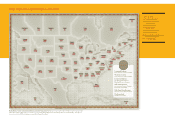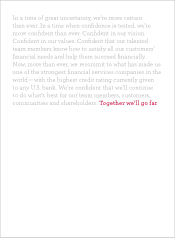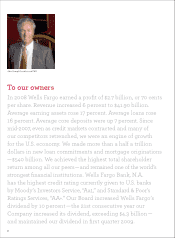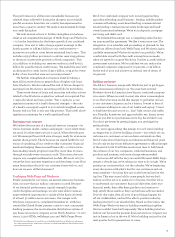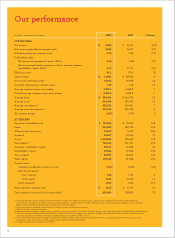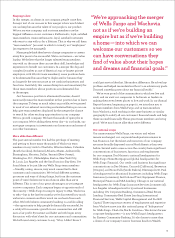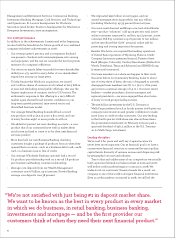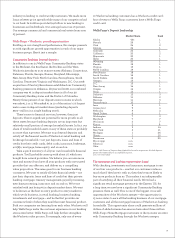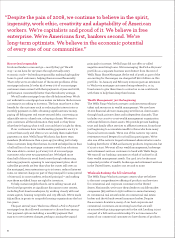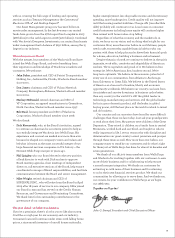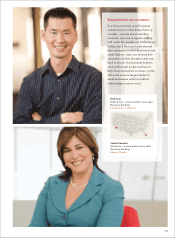Wells Fargo 2008 Annual Report Download - page 5
Download and view the complete annual report
Please find page 5 of the 2008 Wells Fargo annual report below. You can navigate through the pages in the report by either clicking on the pages listed below, or by using the keyword search tool below to find specific information within the annual report.
This performance is all the more remarkable because our
talented team achieved it during the sharpest, most volatile,
painful economic downturn our country has experienced in
more than a quarter century. We made some mistakes but kept
our credit discipline.
We took several actions to further strengthen our balance
sheet as we completed the merger of Wells Fargo and Wachovia
— to lay the foundation for the future growth of our combined
company. One was to take a charge against earnings in the
fourth quarter to add $5.6 billion to our credit reserves —
money we set aside to cover future estimated loan losses. This
includes a $3.9 billion provision to conform reserving policies
to the most conservative practices of both companies. This
is in addition to building our reserves earlier in 2008 by $2.5
billion for possible future credit losses. We ended the year with
an allowance for credit losses of $21.7 billion, or $3.20 for every
dollar of our loans that were not accruing interest.*
We further strengthened our balance sheet by taking a
$37.2 billion write-down on $93.9 billion of higher-risk loans
from Wachovia. We also reduced the risk of future charges to
earnings from Wachovia’s securities portfolio by $9.6 billion.
These write-downs of loans and securities and other actions
related to the Wachovia acquisition reduced our reported Tier
1 capital by about 230 basis points. Tier 1 capital is a core
regulatory measure of a bank’s fi nancial strength — the ratio
of a bank’s core equity capital to its total risk-weighted assets.
At year end our Tier 1 ratio was 7.84 percent. That’s well above
regulatory minimums for a well-capitalized bank.
Emerging even stronger
We believe the true test of a fi nancial services company — its
vision, business model, culture and people — is not when times
are good. It’s when times are not so good. When the tide goes
out. We emerged from 2008 even stronger, ready for even more
market share growth. That’s because we stayed faithful to our
vision of satisfying all our credit-worthy customers’ fi nancial
needs and helping them succeed fi nancially — a vision we’ve
been making steady progress toward for more than 20 years,
through virtually every economic cycle. This vision does not
require any complex mathematical models. All we do is try to
create the best customer experience and then keep count: How
many fi nancial products do our customers have with us, and
how can we earn all their business?
Combining Wells Fargo and Wachovia
Firmly grounded in our vision, we earned even more business
from our more than 40 million customers in 2008. Because
of our fi nancial performance, capital strength, liquidity,
credit discipline and earnings, we also were able to seize an
unprecedented opportunity to satisfy all the fi nancial needs
of at least 30 million more customers. Our merger with
Wachovia Corporation, completed December 31, 2008, has
created the United States’ premier coast-to-coast community
banking presence, the most extensive distribution system of
any fi nancial services company across North America — 11,000
stores, 12,300 ATMs, wellsfargo.com and Wells Fargo Phone
Bank. Our combined company is #1 in mortgage lending,
agricultural lending, small business lending, middle market
commercial banking, asset-based lending, commercial real
estate lending, commercial real estate brokerage and bank-
owned insurance brokerage. We’re #2 in deposits, mortgage
servicing, and debit card.
We believed this merger was a compelling value the day
we announced the agreement. We like it even more now. The
integration is on schedule and proceeding as planned. In late
2008 loan o cers from both Wells Fargo and Wachovia again
carefully reexamined Wachovia’s entire loan portfolio. We’re
comfortable overall with the credit assumptions we made
when we agreed to acquire Wachovia October 3, 2008, without
government assistance. We’re confi dent we can reduce the
combined company’s expenses by 10 percent, or $5 billion,
by the end of 2010 and achieve an internal rate of return of
20 percent.
Building our house
We did not, however, merge with Wachovia just to get bigger.
Size alone means nothing to us. You may have noticed:
Nowhere above do I mention how big our combined company
is in assets. Where we rank in asset size alone is meaningless
to us. That’s because we did this merger to get better. In fact,
to our customers, bigness can be a barrier. I’ve yet to hear of
a customer walking into one of our banks and saying, “I want
to bank here because you’re so … big!” Safe, secure and stable,
yes. Friendly, hometown and approachable, yes. Smart, savvy,
ethical, yes. But not just because we’re big. As we like to say:
You don’t get better by getting bigger, you get bigger by
getting better.
So, we’re approaching this merger not as if we’re building
an empire but as if we’re building a home — into which we can
welcome our customers so we can have conversations they
fi nd of value about their hopes and dreams and fi nancial goals.
It took only 90 days from defi nitive agreement to o cial merger
at the end of 2008. It will take much more time to fully blend
the cultures of our two companies, combine businesses and
products and systems, and name-change where needed.
Just as we did with the very successful Norwest-Wells Fargo
merger a decade ago, we’re taking our time to do it right. We’re
putting our customers fi rst, not the calendar. We’re beginning
every discussion with what’s best for our customers and our
team members — focusing fi rst not on the bottom line but the
top line. This may sound odd to some people, but we don’t
believe our fi rst job is to make a lot of money. Our fi rst job is
to understand our customers’ fi nancial objectives, their true
fi nancial needs, then o er them products and services to
help satisfy those needs so they can be fi nancially successful.
If we do that right, then all sorts of good things happen for
all our stakeholders, and we’ll be able to produce industry-
leading returns for our shareholders. Based on this vision, the
Wells Fargo-Wachovia team is building something together
that we couldn’t have built separately. We’re building what we
believe can become the premier fi nancial services company not
just in America but in the world. We’re building not just for the
next quarter but for generations to come.
* At 12/31/08, our allowance for credit losses excluded $12.0 billion of Wachovia’s allowance
for credit-impaired loans, and nonaccrual loans excluded $20.0 billion that Wachovia had
reported as nonaccrual.


